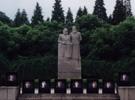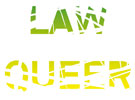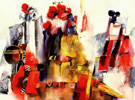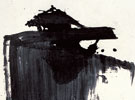In Untitled, a large-scale representative oil painting, three strong laborers with their backs to the audience are turning a huge wheel axle. The black wheel axle, the brown figures’ backs and the beige background, bestow a masculine strength and a steady and distinctive visual effect to the picture. In another small-sized Untitled, a person sits on an ordinary round stool with his back to the audience, and in the picture we could only see the red round stool and the lower body of the dark-colored person with an effect of strong comparison, which is also a very meaningful painting.
Sometimes, she presented a certain scene of laboring, for instance, in Moving Apples created in 1985, she placed the whole pile of apples and the baskets used to move apples in the most conspicuous and lighted positions, and depicted the smallest concerned details, however the people carrying apples usually retreated into the background, and we could only discern a pair of legs slightly bending for moving heavy things. Nevertheless, this didn’t mean the figure’s position in the picture was dispensable, on the contrary its appearance touched the audience’s nerve of sentiment. The strong and solid legs partially hidden in the painting’s background set off the fruit’s sweetness and preciousness, also strengthened the picture’s emotional elements.
What’s noticeable is, “hand” is also a emotional symbol often appearing in her paintings, however, they are not delicate hands, but the rough hands of strong laborers, always in the almost same gesture, holding a big loaf of bread, or holding a big apple, thus a significant and heavy relation forms between the laborer’s hands and food.
In her paintings, the self-portraits or the women figures with the painter’s self-projection are more personal or private. She painted herself in creation, herself buying bread, herself cutting fabric, and also herself contemplating or reading books under the lamp at night… Herself/woman in her paintings is lonely, but also self-dependent and strong. These self-portraits under different circumstances vividly outline the real situation of a woman painter striving in Paris.
From the 1980s, she created more paintings of still lives. Her still life painting could be approximately divided into the vegetable and fruit series and the flower and tree series. However, the still lives in her paintings were of a wide variety, and various eye-catching or insignificant trivial objects could all be represented in her paintings, such as clothes, umbrella, ruler, ashtray, book, bread, and even the paintings in her studio could appear in her paintings in the way of still life.
Facing these familiar and common things necessary in daily life, she applied strong colors and highly concise means to represent them. These objects usually occupied exceptionally large area in the pictures, their volumes often filled the whole space in the pictures with strong visual expansion. As providing necessary energy for life, the food in her paintings including vegetables, fruits, bread, and etc, got extremely high compliments and eulogies in her paintings. As for those commonest fruits, such as apple, banana, pear, and etc, and those commonest vegetables, such as eggplant, green pepper, pumpkin, scallion, lotus seedpod, and etc, we obtain a sort of new perception and edification from them in Hoo’s paintings, and also derive plain comprehension and transcendence of life from them.
The flower and tree series appeared around the 1990s, and increased in quantity after 2000. Though most were cultivated potted landscapes and flowers in vases, the rough, straightforward and forceful brushstrokes, the strong colors, and the constructionistic patterns, all these presented a visual view full of vivid vitality.
In these paintings of still lives, for the balance of composition and colors, she sometimes added some color fields and symbols, which didn't seem to have any logical relation with the depicted objects but enriched the paintings and even added a certain indescribable vividness and mystery.
Disregarding landscape painting’s small quantity in Hoo’s creation, they have a particular flavor. The perspective of close view, the full composition, the village’s tranquility and simplicity, all these were manifested through old trees, bamboo stools, wood ladders, cottages, the warm colors of orange-yellow and ochre, and the blue sky. There was no figure, no chicken or dog, all lives seemed to be in sound sleep, presenting such a silent and unreal scene as if in dream. These landscapes were more like the painter’s inner landscapes in a certain sense. I notice, these landscape paintings were mostly created at the end of the 1980s and the beginning of the 1990s, and the painter in her seventies obviously began to be more and more nostalgic. As a matter of fact, soon enough her solo exhibition was successfully held in Shanghai Art Museum in 1996. Later, she flied between Shanghai and Paris more frequently, forming a closer connection with her homeland. Therefore, I suppose the landscape paintings created in this period could be regarded as reflection of the painter’s nostalgic emotion – the landscapes of her homeland created through the combination of her memory, imagination and emotion.
Nowadays, in her living-room/studio in Shanghai, this grandmother painter is still working in high spirit. Her newest attempt is to paint with ink and oil paint mixed together on rice paper. The several pieces of “potted flowers” created in this way are bold , vigorous and unscrupulous, having an extraordinary touch compared with her oil painting, and a sort of profound strength only belonging to herself compared with other common ink paintings on similar themes.
III. Conclusion
The 20th-century passed quickly among continuous and complicated social changes and institutional transformations in China, and the 20th century in Chinese art history also recorded and verified the track of these changes and transformations in its own way. When reviewing this part of history in the current 21st century, we inevtably discover shortage and deficiency among profuse and varied visual art creation. We find that many of the works were influenced and interfered by various non-artistic elements, deeply marked with the brand of the era. Serving different objects and purposes in different historical periods, they resulted in very limited researches on art itself and inadequate cultivation of artists’ free individuality. When reviewing this part of art history, we often applaud those predecessor artists with outstanding talent and passion, but also feel pity for the small number of artists exploring on the way of art ontology. After the reform and opening to the outside, though multiple tendencies of free development appeared in Chinese art, the habitual thought of "emphasizing contents beyond expressions and emphasizing concepts beyond forms" still existed in the creation of contemporary art in various potential ways. As an overseas Chinese artist away from Chinese mainstream art system for quite a long time, Hoo’s overseas art practice for more than half a century and her spectacular painting accomplishment are undoubtedly a valuable and important complement to Chinese art history from the 1950s. And I believe, her researches on painting’s ontological language and her individual and essential ways of viewing the world also have the positive significance of being used as reference.
Meanwhile, from the perspective of female art, Hoo’s experiences and achievements also provide a great example for Chinese women artists’ creation. Being a woman myself, I find the most important elements about Hoo are her broad vision and strength, which was delivered through inner and humbleness instead of superficial greatness, and how wonderful that is!
Life and figures in memory, still lives and landscapes, these are the permanent themes in Hoo’s paintings. They are so common, but also possess the sense of transcendence. In a certain sense, no matter the figures, or still lives, or landscapes, they are all restored into their original natures as substance in her works, and are also bestowed the spirit and strength of life. They are ordinary, but also extraordinary at the same time.
Chinese philosophy thinks everything has its spirit, and western belief presumes humbleness verifies divinity, with the premise that we must have the charitable and innocent heart towards all the humble things so that we could really observe the trivial details and discover the brightness.
Ms. Hoo Mojong’s works only present common things in daily life, therefore, she could exert an artist’s talent and compassion into an extremely high and huge realm, and then they could shine with such eternal and impressive charm.
Jiang Mei
Curator of Shanghai Art Museum
Written before dawn on January 17, 2011










